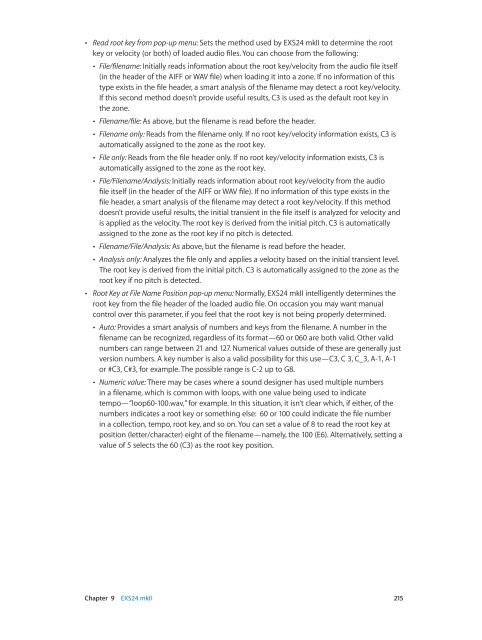Apple MainStage 3 Instruments - MainStage 3 Instruments
Apple MainStage 3 Instruments - MainStage 3 Instruments
Apple MainStage 3 Instruments - MainStage 3 Instruments
You also want an ePaper? Increase the reach of your titles
YUMPU automatically turns print PDFs into web optimized ePapers that Google loves.
••<br />
Read root key from pop-up menu: Sets the method used by EXS24 mkII to determine the root<br />
key or velocity (or both) of loaded audio files. You can choose from the following:<br />
••<br />
File/filename: Initially reads information about the root key/velocity from the audio file itself<br />
(in the header of the AIFF or WAV file) when loading it into a zone. If no information of this<br />
type exists in the file header, a smart analysis of the filename may detect a root key/velocity.<br />
If this second method doesn’t provide useful results, C3 is used as the default root key in<br />
the zone.<br />
••<br />
Filename/file: As above, but the filename is read before the header.<br />
••<br />
Filename only: Reads from the filename only. If no root key/velocity information exists, C3 is<br />
automatically assigned to the zone as the root key.<br />
••<br />
File only: Reads from the file header only. If no root key/velocity information exists, C3 is<br />
automatically assigned to the zone as the root key.<br />
••<br />
File/Filename/Analysis: Initially reads information about root key/velocity from the audio<br />
file itself (in the header of the AIFF or WAV file). If no information of this type exists in the<br />
file header, a smart analysis of the filename may detect a root key/velocity. If this method<br />
doesn’t provide useful results, the initial transient in the file itself is analyzed for velocity and<br />
is applied as the velocity. The root key is derived from the initial pitch. C3 is automatically<br />
assigned to the zone as the root key if no pitch is detected.<br />
••<br />
Filename/File/Analysis: As above, but the filename is read before the header.<br />
••<br />
Analysis only: Analyzes the file only and applies a velocity based on the initial transient level.<br />
The root key is derived from the initial pitch. C3 is automatically assigned to the zone as the<br />
root key if no pitch is detected.<br />
••<br />
Root Key at File Name Position pop-up menu: Normally, EXS24 mkII intelligently determines the<br />
root key from the file header of the loaded audio file. On occasion you may want manual<br />
control over this parameter, if you feel that the root key is not being properly determined.<br />
••<br />
Auto: Provides a smart analysis of numbers and keys from the filename. A number in the<br />
filename can be recognized, regardless of its format—60 or 060 are both valid. Other valid<br />
numbers can range between 21 and 127. Numerical values outside of these are generally just<br />
version numbers. A key number is also a valid possibility for this use—C3, C 3, C_3, A-1, A-1<br />
or #C3, C#3, for example. The possible range is C-2 up to G8.<br />
••<br />
Numeric value: There may be cases where a sound designer has used multiple numbers<br />
in a filename, which is common with loops, with one value being used to indicate<br />
tempo—“loop60-100.wav,” for example. In this situation, it isn’t clear which, if either, of the<br />
numbers indicates a root key or something else: 60 or 100 could indicate the file number<br />
in a collection, tempo, root key, and so on. You can set a value of 8 to read the root key at<br />
position (letter/character) eight of the filename—namely, the 100 (E6). Alternatively, setting a<br />
value of 5 selects the 60 (C3) as the root key position.<br />
Chapter 9 EXS24 mkII 215
















